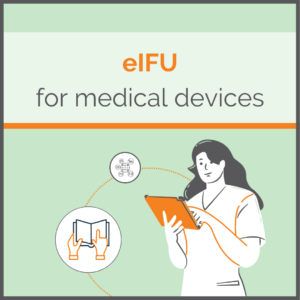
Electronic Instructions for Use (eIFU) are digital versions of traditional printed instructions for medical devices. They offer numerous advantages, including improved accessibility and reduced paper consumption. The current situation in the EU, global regulations, and future requirements for medical device manufacturers are discussed in the following article.
In Europe, eIFUs have been a topic since 2012. Regulation (EU) No. 207/2012 was replaced on December 14, 2021, by Implementing Regulation (EU) 2021/2226. This new regulation sets out the requirements and conditions under which eIFUs may be used for medical devices distributed in the EU.
Current Conditions for Using eIFU in the EU
The use of eIFUs is subject to certain conditions related to the user, the product, the manufacturer, and the website:
- User: eIFU is only permitted for products used by professional users. For software products, the use of eIFUs is also allowed for laypersons.
- Product: eIFU may only be used for certain product categories, such as implantable and active implantable medical devices and fixed installed medical devices and their accessories.
- Manufacturer: Manufacturers must ensure that the eIFU is always accessible and that a printed version can be provided upon request within a short time.
- Website: The eIFU must be available on the manufacturer’s website. The website must be user-friendly and provide the eIFU in the official language of the respective member state.
eIFU and Its Advantages
The introduction of eIFUs offers numerous advantages for both users and manufacturers. According to BVMed, eIFUs can significantly reduce paper consumption and make packaging smaller and lighter without compromising safety. Additionally, it is currently a major logistical challenge to provide IFU in all national languages in paper form and to include them with medical devices in the most current version. Both points not only reduce costs but also positively impact product safety. Through the digital version, instructions for use are always available in all versions and languages without limitation. For example, in a hospital, two doctors can use two identical devices in parallel and access the instructions for use in their respective native languages without having to search for the appropriate documents first. Other advantages include improved handling and the ability to incorporate multimedia content such as videos or animations.
- Environmental friendliness: eIFUs reduce paper consumption and packaging size, leading to less environmental impact.
- User-friendliness: eIFUs are easily accessible and can contain multimedia content such as videos or animations that improve handling and understanding.
- Cost savings: Manufacturers can save costs by using eIFUs, as the logistical challenge of providing printed instructions in various languages is eliminated.
The German BVMed says: “Therefore, BVMed demands that Europe should at least extend the current scope of the eIFU regulation to all medical devices and their accessories intended for professional use.” – BVMed Managing Director Dr. Marc-Pierre Möll
Learn more about the advantages of eIFUs, especially for users, in the Medical Mountains podcast (the Podcast is in German, but you can use the automated YouTube subtitles for translation).
The EU Draft Regulation and What It Means for the Future of eIFU
The EU is not the only region working with digital instructions for use. Internationally, many countries have recognized the advantages of eIFUs and allow them under various conditions. These include the FDA (USA), Health Canada (Canada), TGA (Australia), ANVISA (Brazil), SFDA (Saudi Arabia), PMDA (Turkey), and MoH (India). The further establishment of eIFU in the EU also contributes to the competitiveness of medical device manufacturers based here.
In the EU, the conditions and requirements are still evolving. The EU Draft Regulation, which amends Implementing Regulation (EU) 2021/2226, aims to further facilitate and expand the use of eIFUs. These changes particularly affect medical devices for which instructions for use may be provided in electronic form. Some non-implantable products are affected. Accessibility requirements are stricter. They must be easily accessible and available in all EU official languages. Security standards protecting eIFUs from third-party access are also increasing. When manufacturers provide eIFUs in the future, they are required to notify the competent authorities. This includes linking the eIFUs (URLs) in EUDAMED with the corresponding product data.
These changes are designed to promote the further use of eIFUs and advance digitalization in healthcare. They offer more flexibility and security for both manufacturers and users. At the same time, the requirements for the eIFU system are increasing. For the majority of medical technology manufacturers, the question of how they can provide eIFUs in a legally compliant manner will arise in the future.
[Disclaimer] The information provided is only a possible interpretation of the regulations. These are constantly changing, so the information in this article may be incomplete or outdated. The above article is expressly not legal advice. Please refer to the official documents before making business decisions. (Information status: April 2025)